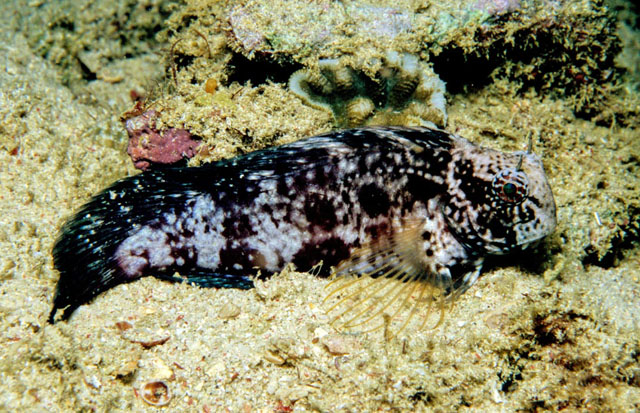| Blenniidae (Combtooth blennies), subfamily: Salariinae |
| 7.38 cm SL (male/unsexed) |
|
reef-associated; marine; depth range 10 - 20 m |
| Western Pacific: Japan to Papua New Guinea. |
|
Dorsal spines (total): 10-10; Dorsal soft rays (total): 20-21; Anal spines: 2-2; Anal soft rays: 20-21; Vertebrae: 34-36. Description: Dorsal fin X, 20-21; anal fin II, 20-21 (usually 21); pectoral rays 17; pelvic fin I,2; caudal fin segmented-rays 11. Body deep, 3 in SL. (Ref. 90102). With a broad, flat supraorbital cirrus, dorsal fin broadly contacting caudal fin, anal fin narrowly contacting caudal fin, long posteriormost soft dorsal (16.1-24.9%SL) and anal fin rays, first or posteriormost soft dorsal fin ray shortest, first soft anal fin ray shortest, caudal fin rays branched in specimens over 3.6 cm SL, no large dark spot on base of pectoral fin, no red margin on anterior dorsal fin (Ref. 35866, 90102). Overall dark brown (black underwater). Juveniles have white vertical bars on body to dorsal fin but disappears at maturity (Ref. 90102). |
| Adults inhabit coral reefs (Ref. 42594). Found among the branches of both living and dead corals on a shallow coral reef (Ref. 35866). Oviparous. Eggs are demersal and adhesive (Ref. 205), and are attached to the substrate via a filamentous, adhesive pad or pedestal (Ref. 94114). Larvae are planktonic, often found in shallow, coastal waters (Ref. 94114). |
|
Least Concern (LC); Date assessed: 24 March 2009 Ref. (130435)
|
| harmless |
|
Known from Palawan and Siquijor (Ref. 35866, 90102), . |
Source and more info: www.fishbase.org. For personal, classroom, and other internal use only. Not for publication.

